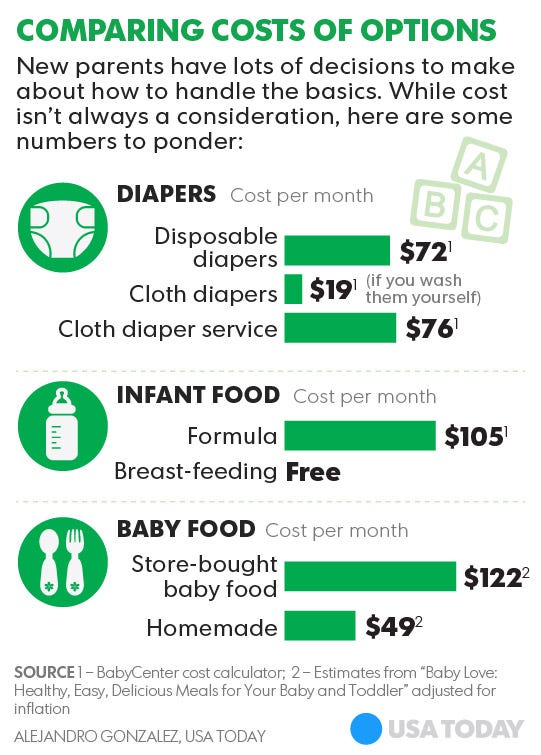Old school vs. new school: How to cut the costs of raising a baby
Ask any parent about the costs associated with raising a baby, and you'll encounter a bevy of mixed emotions. After all, having a child is an exciting milestone, but it's also an investment. In a baby's first year of life, a middle-income family can expect to spend $16,180, according to the USDA.
Aside from the sticker shock, parents need to consider that having a baby is a lifestyle change, and preparing financially can make a difference. "Our family wanted to have a second child, so before the baby came, we saved about $8,000," says Thelma Luisa Anderson, 35, a married mom of two boys, ages 19 months and 11 years, who works as a hairstylist in Teaneck, N.J. "You're always going to need something for the baby, so set aside that money upfront."
Some would-be parents may ponder if they will fare better using traditional vs. modern ways of caring for their cherub. "There are always trade-offs to time and money," says Crystal Stranger, an accountant and author of Pro Choice: A Financial Guide for Women. "It really depends on personal choices and belief systems more than anything else."
How day care costs could lead parents to prosperity
We spoke to parents and family finance experts to compare the costs, benefits and time commitments of old-school baby-rearing vs. more modern ways. Here's what we discovered.
• Breast-feeding vs. bottle. Breast-feeding is less expensive than formula, and health professionals applaud the benefits for the baby. Even buying a higher-end breast pump like the Medela In Style ($269.99 on toysrus.com) is cheaper overall than formula. But for some moms, like Laura Knolle, a certified financial planner at EP Wealth Advisors in Lafayette, Calif., and a mom of a 19-month-old, the decision to breast-feed had less to do with cost savings than a healthy start for her baby. "I would estimate that I saved $60 per month (the cost of two boxes of dry formula) or $720 a year by breast-feeding," Knolle says. "However, nursing is a major task for a new mom, especially one who works full time." And the savings? "Our bodies require more calories, so I'm sure I ate more than I saved," she says.

• Cloth diapers vs. disposables. Disposable diapers are the ultimate convenience item. Babycenter.com estimates that disposables will cost new parents $72 per month, but parents can buy them for less at retailers like Walmart and Costo. If you decide to go au natural and do it yourself with cloth diapers, expect to shell out only $19 per month, plus a small bump-up in water and electricity usage. On average, that’s a savings of $53 per month, or $636 per year.
Stranger, who has a toddler and another baby due in January, expects to use some cloth diapers this time around in addition to disposables. Her top choice is Green Nursery’s Tots Bots, which boasts Velcro tabs and costs 60% more than typical cloth diapers at $598 for a 24-pack. “Cloth diapers make it easier to transition to toilet training because the child can feel when they are wet,” says Stranger. The cost of diapers vs. disposables comes down to the type you buy, how many your baby uses daily, and how long it takes to potty train. Either way, shop around to get the best deal.
More moms and dads may be parenting by the (science) book
Making food vs. buying. Some parents like the convenience of more costly food on-the-go to supplement their more affordable home cooking. Even though her son Rey Alexander is almost 2, busy mom Anderson still sometimes gives him baby food in a jar. "He loves the fruits! When you buy, you move quicker and it's a one-shot deal, but when you're cooking, you have to take more time," says Anderson, who spends, at a maximum of $1.50 per jar. Food-preparation systems like the Baby Bullet, which retails for $59.99, are good for providing everything you need to make healthy, nutritious food for less, overall. However, some working parents — like Anderson, who works 40+ hours a week — don't have the luxury of extra time.
Gently used baby gear vs. new. It's fine to accept secondhand clothing and toys from family or friends, but when it comes to cribs, strollers and car seats, buy new, says Brett Graff, author of Not Buying It: Stop Overspending and Start Raising Happier, Healthier, More Successful Kids. At a thrift shop, you don't know the year something was made, so it may not be up to today's standards. However, you don't have to spend thousands. "Buying a more expensive, crib or car seat won't make your child safer, because they all have to abide by the same safety standards." To save on these big-ticket items, add them to your registry or crowdsource your baby's first savings account at babyfund.com.
When it comes to raising babies, Graff says it doesn't come down to one choice over another. "Evaluate your choices, know what you're buying, and do what's best for your family," she says.